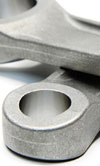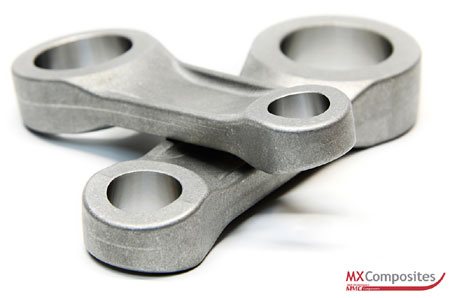Metal-matrix composite rods
 In my previous article on the subject of con rods I asked, "Can we manage without big-end bearings?" and went on to look at the various attempts to do this and the possible future options. The article briefly mentioned the benefits of not having a bearing, and observed that there is one currently successful application of bearing-free technology being raced.
In my previous article on the subject of con rods I asked, "Can we manage without big-end bearings?" and went on to look at the various attempts to do this and the possible future options. The article briefly mentioned the benefits of not having a bearing, and observed that there is one currently successful application of bearing-free technology being raced.
In the application concerned - four-stroke, single-cylinder race engines with 'assembled' cranks, where the crankshaft isn't a single piece but is assembled with the con rod in place - there is an advantage in terms of design simplicity: the con rod can be a single piece rather than an assembly split at the big end. This means that there is neither a requirement for bolts to secure a cap, nor dowels or pins to ensure correct rod-to-cap alignment.
The con rods in question are made of metal-matrix composites (MMCs), and an early Race Engine Technology Monitor article goes into some detail regarding the properties of such materials and their application to con rods.
There are obvious advantages to using such materials for con rods, even if we can't dispense with the big-end bearing. The low mass of the con rod means transient engine response should be improved, and indeed power output should also be improved because of the lower frictional loads due to the lighter rod. There is potentially further scope for optimisation by further lightening the crankshaft based on the lighter rod.
I spoke to rod manufacturer MX Composites, from Sweden, which specialises in four-stroke motocross rods made from MMCs (see Fig. 1).

Operations and sales manager Claes Isaksson told me the company has supplied rods to many successful riders and teams; Fig. 2 shows Filip Bengtsson, who is currently challenging for the Swedish MX2 championship using MMC rods.

MMC properties are due to the addition of small particles of silicon carbide to the aluminium matrix. These additions, however, have the unpopular side-effect that the material becomes difficult to machine. This is partly why some of the more popular rods are made from near net-shape forgings.
The machining of the material is also a very specialised process, using special tooling and a high-speed machining technique originally developed by Saab. Isaksson says, "High-speed machining is one of the keystones in this process, as are the special tools being used."
In many ways motocross is an ideal arena in which to test a rod without a bearing. The engines are simple but highly tuned, and are stripped and rebuilt regularly, giving ample opportunity to gauge the condition of the internals. The move away from the standard needle roller came because it was felt that the original big end of the rod was rather large, so there was a desire to see if the needle roller was really required. From the work undertaken, it appears that there are cases where the needle-roller may be dispensed with.
With these motocross rods running a hydrodynamic bearing, but without a shell, how long will it be before we see this technology more widely applied?
Fig. 1 - MMC rods are mechanically simple but require special machinery and tooling for production (Courtesy of MX Composites)
Fig. 2 - Swedish MX2 contender Filip Bengtsson uses MMC rods to good effect (Courtesy of MX Composites)
Written by Wayne Ward